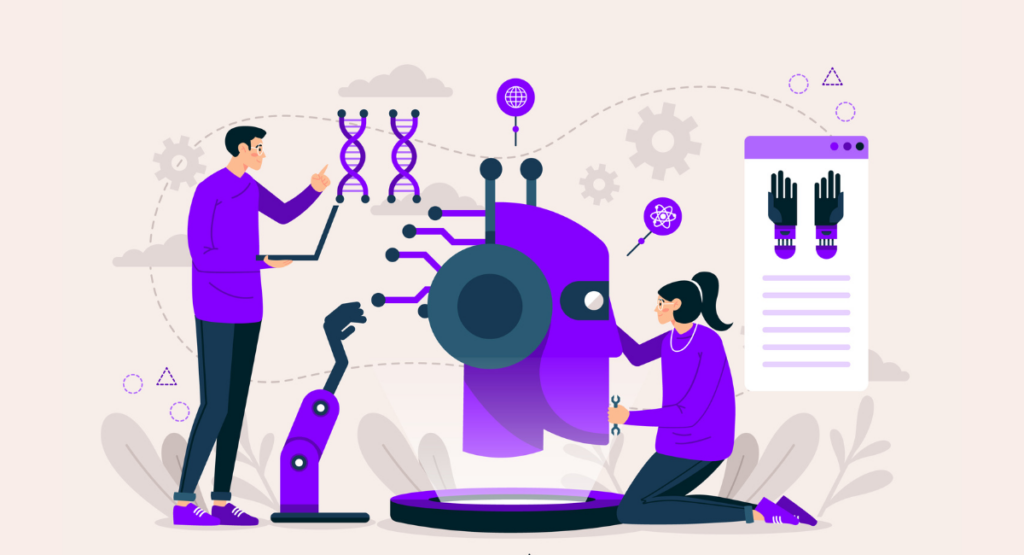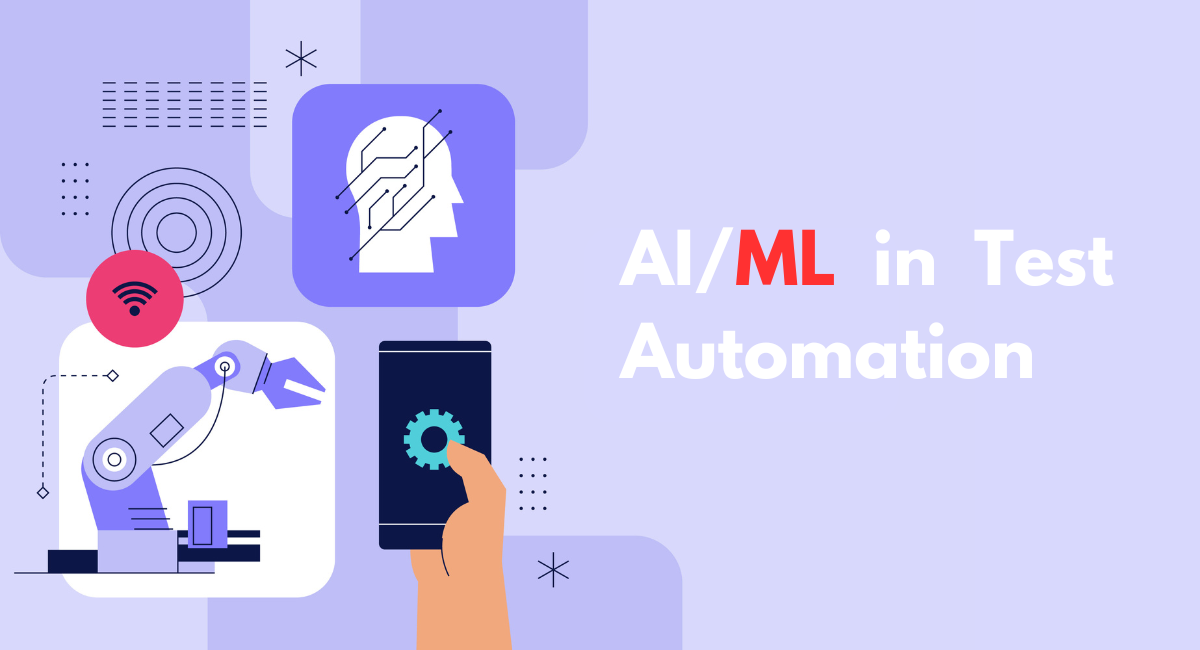The integration of Artificial Intelligence and Machine Learning in test automation is changing the landscape of software development drastically. With changing technology, traditional methods of testing are getting overridden by more intelligent and efficient solutions.
AI and ML are not tools but transformative forces that are reshaping how Quality Assurance is implemented in Software projects. This will make the test procedures more accurate, efficient, and effective in a way that better fits modern, agile production rhythms.
Shattering these boundaries and pushing your team ahead of the curve of innovation is only a starting point. Being ready for a future powered by technology to make testing smarter, faster, and more reliable involves the first step of understanding how AI/ML impacts test automation.
The Role of AI in Test Automation

Understanding AI in Test depictionAutomation
AI in test automation is the application of AI technologies machine learning, natural language processing, and robotics to the testing process for its improvement and acceleration.
AI can analyze data from previous runs to predict key parameters of testing processes and optimize the coverage of the test. Accordingly, the capability reduces not only the need for manual intervention but also enhances the accuracy and efficiency of test suites.
Benefits of Using AI in Test Automation
Integrating AI into test automation makes a number of compelling benefits:
- Efficiency: Automated tests are way faster, more able to deploy complex scenarios, nearly free from human error.
- Precision: It can detect small deviations from the expected outcome with better quality from the software under development.
- Cost Reduction: The company will be able to reduce the cost of testing to a large extent by automating more components, hence eliminating man-made testing.
- Flexibility: If the test cases or the software under test change, there is no additional setup time needed AI-driven test automation adapts easily to these changes.
- Predictive Capabilities: AI predicts possible future defects from past data, and thus helps in correction before they occur.
The significance of ML in Test Automation
Delving into Machine Learning
Machine learning is an important subset of AI. It involves training algorithms to make decisions based on prior data. In test automation, ML can learn from the results of past test cases and adapt strategies aimed at making the tests more effective and efficient.
This dynamic adjustment is quite useful in a CI/CD environment where even code changes are frequent.
Advantages of Implementing ML in Test iautomationceMappinggnificance
ML significantly boosts the capabilities of test automation systems by:
- Enhancing Test Suit Evolutions: ML can predict the most efficient test cases and identify redundant tests that can be omitted.
- Increasing Accuracy: By continually learning from new data, ML models fine-tune their predictions and error detection capabilities.
- Reducing Maintenance: Auto-generating and updating test cases based on learned behaviors reduces the need for continuous manual oversight and updates.
ML Algorithms for Test Automation
Several machine learning algorithms have proven useful in the context of test automation:
- Neural Networks: Ideal for pattern recognition, which can be used to identify and predict issues before they manifest.
- Decision Trees: Useful for classification problems to determine how actions will affect outcomes.
- Reinforcements Learning: Helps in adapting test strategies based on the results of prior test executions.
How AI and ML Complement Each Other
AI (Artificial Intelligence) and ML (Machine Learning) are two reliant technologies that have tremendously given more leverage to the additional capability in test automation.
AI grounds intelligent-based algorithms to predict the outcome and make a decision for selecting the test cases and prioritizing them, whereas ML is continuous learning from data inputs to fine-tune and enhance the testing process.
Together, they enable a dynamic test environment in which test suites are not only self-evolving but also increasingly efficient at detecting defects. This synergy can reduce false positives, reduce manual review processes, and make testing life cycles more efficient.
Case Studies Showcasing Integration Success
Some high-profile case studies demonstrate the successful integration of AI and ML into test automation:
1. Global Financial Services Company: Applied AI-based test automation in their mobile and web solutions, which resulted in a 40% reduction in testing time and 30% fewer defects post release.
2. Health Tech Company: ML algorithms on analyzed data from their test history optimized test cases by 50% and increased the extent of test coverage by 20%.
3. E-commerce Giant: Develop a customized AI framework for its CI/CD pipeline which automatically updates testing protocols depending on incoming real-time user data and application changes.
In such cases, the use of AI/ML techniques does testing automation more effectively and ultimately empowers the organization to realize quite wide operational and quality paybacks.
The Future of Test Automation with AI & ML

Predictions for AI & ML in Test Automation
The future of test automation with AI and ML looks promising, with several key trends emerging:
- Self-Healing Systems: AI will advance to where test automation frameworks can self-correct and adapt in real-time without human intervention.
- Predictive Analysis: ML models will enhance their predictive capabilities to ascertain potential future bugs based on historical data, thereby preemptively fixing issues before they escalate.
- Cross-Platform Testing Automation: With more digital platforms converging, AI and ML will drive more robust cross-platform testing strategies that can adapt across devices and operating systems seamlessly.
Innovations Shaping the Future
Innovations in AI and ML are paving the way for smarter and more efficient test automation processes. Some of the most notable include:
- Natural Language Processing (NLP): This enables the generation of test cases in simple English. This makes it easier to undertake by users who do not understand how to code.
- Visual Testing Tools: The tools leverage AI to autoprobe the visual differences between what is anticipated and what has been potentially received from output of various dimensions of screens and display resolutions.
- Smart Analytics: ML-driven analytics that go deeper in explaining test results, avoiding teams' expenditure of time in areas like performance bottlenecks or security vulnerabilities.
Not only do these developments optimize testing workflows but also allow for the evolution of test automation to be at par with the rapidly changing tech landscape.
When businesses integrate these technologies in an ever-faster cadence, the role AI and ML will play in test automation becomes very key; it can redefine the very concept of quality assurance across industries.
Steps for Organizations to Adopt AI & ML
Adopt a structured approach to seamlessly integrate AI and ML into test automation. Start by assessing the current testing processes and identifying where AI could bring maximum value at the beginning for example, the areas with a high volume of repetitive tasks prone to human mistakes.
Next, build a skilled team with a mix of Test and AI/ML concepts. This might involve training existing personnel or hiring new talent with experience in these technologies.
After the team is in place, the next step would be to choose appropriate tools and technology that will align very well with the current technology stack involved.
Lastly, a pilot project has to be implemented which would keep track of the actions and changes that AI can do for the betterment of testing efficiency and accuracy, further changing strategies accordingly based on the discovery.
Overcoming Challenges in Implementation
The integration of AI into test automation is not devoid of challenges. These have to do with the quality and availability of data, since AI systems require very vast volumes of quality training data.
Ensuring the privacy and security of sensitive or proprietary data is yet another big challenge. Handling these requires rigorous data cleaning and validation processes, coupled with robust security protocols.
Moreover, resistance in teams to change can exist. Handling this will call for strong leadership and change management skills for acceptance by all stakeholders.
Leading in the Fast-Evolving Tech Scene
Importance of Embracing AI & ML in Test Automation
In a fast-changing and ever-more-complex technology landscape, it is critical to incorporate AI and ML in test automation.
These technologies make it possible for teams to manage increased complexity in the scenarios of testing, handle greater datasets, and ensure that the results are returned quickly and reliably for continuous deployment environments.
AI-enhanced testing tools are able to learn from new data and self-improve the algorithms continuously for better efficiency, hence drastically reducing the time and resources used for manual testing.
How to Stay Ahead of the Curve
Moving ahead in today's fast-changing technology requires a much more hands-on approach to learning and adaptation. Your team should be able to keep up-to-date with the latest trends and best practices within AI and ML by regularly attending relevant seminars, workshops, and other related training sessions.
Investments in R&D will yield innovative solutions that keep methods at the apex of the industry. It's also critical to their making a culture of experimentation and collaboration within which any member can try out and integrate various new AI technologies without the fear of failing.
This will not only move your projects ahead but will also keep your team at the forefront in the application of advanced technologies toward solving real problems.
Book a Demo and experience ContextQA testing tool in action with a complimentary, no-obligation session tailored to your business needs.
Conclusion
The landscape of test automation is changing quickly with AI and machine learning, introducing another level of efficiency and effectiveness in testing.
While technology continues to advance at an ever-increasing rate, fitting AI and ML into testing strategies has evolved from an advantage to a requirement for success.
Any organization that wants to keep up will need to invest in training, tools, and culture that support continuous learning and innovation.
Adopting AI-driven test automation helps teams smoothen their workflows, increases the quality of their products, and looks to raise them to a higher level in the quality span.
The future of technology belongs to agile and adaptive organizations; hence, implementing AI and ML in test automation is positioning an organization at the top of the wave in this re-visited dynamic environment.
Also Read - Top QA Technical Interview Questions: What to Expect and How to Answer
We make it easy to get started with the ContextQA tool: Start Free Trial.
